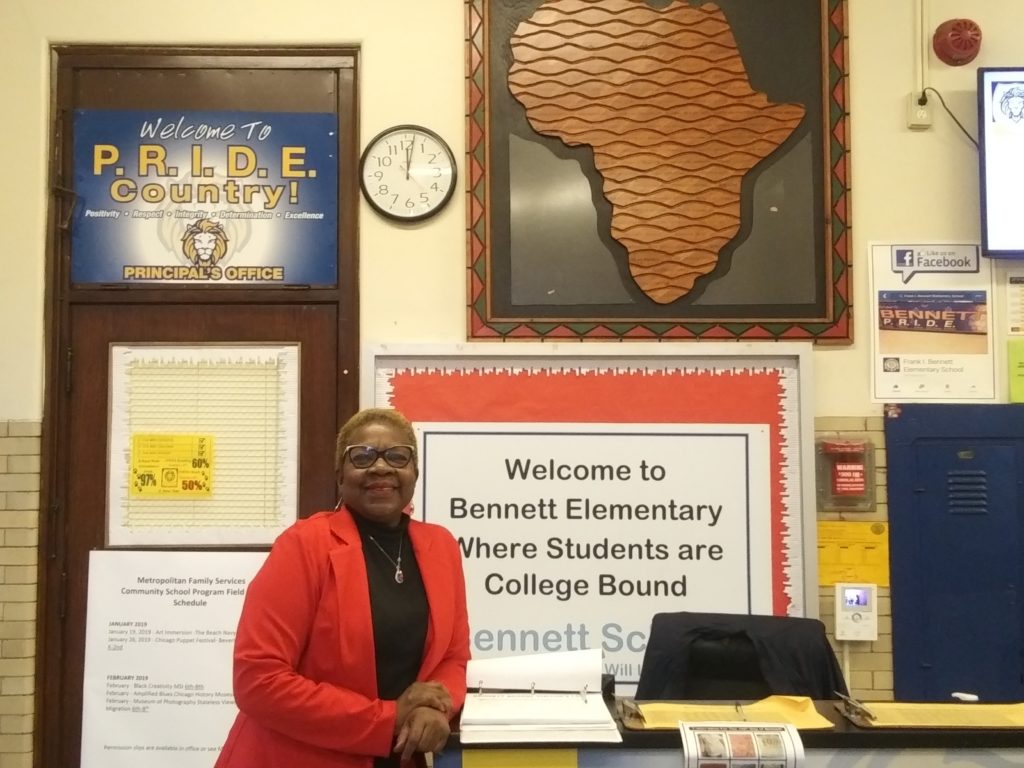Today Principal Teresa Huggins takes pride in her successful turnaround of Roseland’s Bennett Elementary. Since she took the helm in 2013, Bennett has transformed from a school on probation to a school at the top of the district’s accountability ratings. It’s one of 22 neighborhood elementary schools on the South and West sides of Chicago where students are showing high growth on the NWEA MAP test.
But way back in 2001, Huggins was a fifth-grade teacher at Carroll-Rosenwald Elementary on the Southwest Side, pushing herself relentlessly to win National Board Certification. Achieving the highly-prized credential involves a rigorous process of examining one’s own teaching using videotape, student work and reflective essays to compare it against standards of best practice. Huggins took three tries to get there, and her determination paid off.
Huggins earned the credential at a time when the Chicago Public Schools was deeply committed to building a substantial cohort of master teachers certified through the program in hopes of transforming learning across the city. The Chicago Public Education Fund invested $1.3 million over two years in supporting teachers through the process. The Fund’s then-president, Janet Knupp, explained the theory of change: “If you could have teams of master teachers in schools, you could begin to affect teacher retention, school climate and ultimately student achievement.”
Given an urban district’s usually-short attention span for such efforts, this one had surprisingly long legs, lasting nearly a decade. And Huggins’ own story suggests it may be paying off in unexpected ways. While Knupp’s hopes to build teams of board-certified teachers in a large number of schools were not fully realized, Chicago still ranks third in the nation for the number of board-certified teachers, and many serve in a variety of leadership roles. (Like Huggins, recently retired Chicago Teachers Union president Karen Lewis achieved certification during the high-water years of the push.) While many board-certified teachers remain in the classroom, as envisioned, Huggins’ work at Bennett suggests they can have impact as administrators, too.
Huggins’ role in Bennett’s turnaround sounds similar to successful turnaround stories I’ve heard from other principals over the years. When she arrived, she made a point of observing without trying to make big changes right away. “When you come in and try changing everything at once, you rub people the wrong way,” she observed. But once she had the lay of the land, she was unafraid to push for improvement. She insisted on basics like grade-level meetings, teachers showing up on time and taking a hard look at what test score data said about how well students were learning. To increase student engagement, she coupled a behavior reward system with a requirement that teachers schedule quarterly field trips to give students wider experiences beyond the classroom.
To no one’s surprise, teachers pushed back. When Huggins put up data charts by classroom and named the teachers, she received emails complaining, “You cannot call us out.” She emailed the entire staff, reminding them that since they work for the public they must answer to the public. “I didn’t get any more complaints after that,” she said.
Teachers started bringing student work to grade level meetings. Huggins encouraged them to ask themselves questions straight from the National Board playbook: What is the student’s level of understanding? How do you know? What are your next steps as a teacher? Huggins also worked to improve teaching and learning for the 15 percent of Bennett’s students in special education, pushing for greater inclusion and revising IEPs. In her second year as principal, their growth led all the schools in Bennett’s network.
When teachers stepped up their game, Bennett rewarded their efforts with special events, like dinner at a restaurant for the entire faculty on her during staff appreciation week. These days, teachers have built a stronger culture, with a social committee that celebrates birthdays and more teachers staying late after school to plan and prepare. “Sometimes I have to put them out,” she joked.
I talked with Huggins about the Stanford research that shows Chicago’s students making test score gains that outpace nearly all school districts in the country and asked for her thoughts on why this might be happening. Like most experienced educators, she didn’t give the credit to anything that had happened within the last decade. It takes longer for substantive change to cook.
Instead, she looked back on the caliber of those working in the system under Barbara Eason-Watkins, the highly-regarded principal Arne Duncan chose as his Chief Education Officer. During that era, the district had a close relationship with math and reading experts at the University of Illinois-Chicago, who led efforts to train and deploy hundreds of math and literacy coaches across the city. “All the people in that initial group of math and reading coaches are now principals,” Huggins noted. “That had a huge impact on the district. You’re feeling the impact of their leadership.” She wonders what will happen over the next four to five years, as they begin to retire.
As for her own eventual succession, she’s less worried. “I have four people on my staff who are walking down the principalship road. I hope one of them will pick up the torch.”
Maureen Kelleher
Latest posts by Maureen Kelleher (see all)
- CPS Parents Wanted for Research Study - March 27, 2023
- Tomorrow: Cure Violence with #Belonging - August 17, 2022
- Still Looking for Summer Camp? - June 13, 2022
